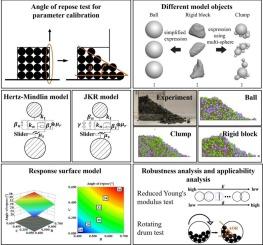Calibration of contact model parameters for aggregates: considering particle shape and moisture content
IF 4.6
2区 工程技术
Q2 ENGINEERING, CHEMICAL
引用次数: 0
Abstract
Aggregates, as typical granular materials, are widely used in pavement and construction engineering, where inter-particle contact significantly influences their mechanical properties. The discrete element method (DEM) effectively simulates nonlinear interactions in aggregate systems, but its accuracy largely depends on contact model parameters. However, most existing calibration approaches simplify particle shape and neglect moisture content effects, leading to inaccurate parameter estimation and limited generalizability. To address this, a systematic and efficient calibration framework is developed that explicitly incorporates aggregate morphology and moisture. Distinct from previous approaches that often focus on either dry or wet conditions and rely on a single modeling representation, the proposed framework integrates particle morphology reconstruction, sequential design-of-experiments (combining Plackett–Burman screening, steepest ascent, and Box–Behnken optimization), and dual contact models (Hertz–Mindlin and Johnson-Kendall-Roberts (JKR)) into an integrated workflow, thereby enhancing both physical fidelity and practical applicability. SMA-11 gradation aggregates made of basalt were used as the study material, and their real geometries were captured via 3D scanning and modeled as balls, clumps, and rigid blocks to evaluate shape influence. Simulations for dry aggregates yield average relative errors of 1.37 %, 1.98 %, and 1.72 % for the three shaped aggregates, while the AOR error for wet aggregates remains below 2 %. These results confirm the accuracy and robustness of the proposed calibration approach, offering reliable support for high-fidelity DEM modeling of aggregate behavior across various conditions.

集料接触模型参数的校正:考虑颗粒形状和水分含量
集料作为典型的粒状材料,广泛应用于路面和建筑工程中,颗粒间接触对其力学性能有重要影响。离散元法(DEM)可以有效地模拟聚集系统中的非线性相互作用,但其精度很大程度上取决于接触模型参数。然而,现有的校准方法大多简化了颗粒形状,忽略了水分含量的影响,导致参数估计不准确,推广能力有限。为了解决这个问题,开发了一个系统和有效的校准框架,明确地结合了聚集体形态和水分。与以往通常关注干燥或潮湿条件并依赖单一建模表示的方法不同,该框架将粒子形态重建、顺序实验设计(结合Plackett-Burman筛选、最陡爬坡和Box-Behnken优化)和双接触模型(Hertz-Mindlin和Johnson-Kendall-Roberts (JKR))集成到一个集成的工作流程中,从而提高了物理保真度和实际适用性。以玄武岩制成的SMA-11级聚体为研究材料,通过3D扫描捕获其真实几何形状,并将其建模为球、团块和刚性块,以评估形状影响。干骨料模拟的平均相对误差分别为1.37%、1.98%和1.72%,湿骨料的AOR误差保持在2%以下。这些结果证实了所提出的校准方法的准确性和鲁棒性,为各种条件下骨料行为的高保真DEM建模提供了可靠的支持。
本文章由计算机程序翻译,如有差异,请以英文原文为准。
求助全文
约1分钟内获得全文
求助全文
来源期刊

Powder Technology
工程技术-工程:化工
CiteScore
9.90
自引率
15.40%
发文量
1047
审稿时长
46 days
期刊介绍:
Powder Technology is an International Journal on the Science and Technology of Wet and Dry Particulate Systems. Powder Technology publishes papers on all aspects of the formation of particles and their characterisation and on the study of systems containing particulate solids. No limitation is imposed on the size of the particles, which may range from nanometre scale, as in pigments or aerosols, to that of mined or quarried materials. The following list of topics is not intended to be comprehensive, but rather to indicate typical subjects which fall within the scope of the journal's interests:
Formation and synthesis of particles by precipitation and other methods.
Modification of particles by agglomeration, coating, comminution and attrition.
Characterisation of the size, shape, surface area, pore structure and strength of particles and agglomerates (including the origins and effects of inter particle forces).
Packing, failure, flow and permeability of assemblies of particles.
Particle-particle interactions and suspension rheology.
Handling and processing operations such as slurry flow, fluidization, pneumatic conveying.
Interactions between particles and their environment, including delivery of particulate products to the body.
Applications of particle technology in production of pharmaceuticals, chemicals, foods, pigments, structural, and functional materials and in environmental and energy related matters.
For materials-oriented contributions we are looking for articles revealing the effect of particle/powder characteristics (size, morphology and composition, in that order) on material performance or functionality and, ideally, comparison to any industrial standard.
 求助内容:
求助内容: 应助结果提醒方式:
应助结果提醒方式:


